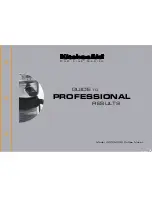
GB
GB
74
Notes on ingredients
Bread flour
Bread flour is the main ingredient in the baking of bread and is recommended in most recipes for yeast bread.
It has high protein and gluten content (it can also be called high gluten flour) and after rising keeps the volume
of the dough and prevents its fall. The flours differ in different areas. Gluten content is higher than in the
medium-ground/fine flour, so that it can be used to bake larger loaves with richer internal texture.
Medium-ground/fine flour
Flour without baking powder suitable for „quick” bread or bread baked in quick program. Bread flour is more
suitable for yeast bread.
Whole grain flour
Whole grain flour is ground from whole cereal grains. Bread made from this flour will have more fibre and
higher nutritional content. Whole grain flour is heavier and in consequence the loaves can be smaller and have
heavier texture.
Contains nutrients from the outer skin of the grain and gluten. Many recipes usually combine whole grain and
bread flours to produce optimum results.
Rye flour
Rye flour, also called dark-grain flour, is a kind of flour high in fibre and is similar to whole grain flour. To achieve
a large volume after rising it must be used in combination with a high percentage of bread flour.
Self-rising flour
Flour containing baking powder, used mainly to bake cakes. Do not use self-rising flour in combination with
yeast.
Corn and oat flour
Corn or oat flour is ground from maize or oats. These flours are optional ingredient when baking coarser bread,
they improve flavour and texture.
Sugar
Sugar is „food” for yeast and enhances sweet taste and the color of the bread. It is a very important element
for rising of the dough. White sugar is usually used, but some recipes may require brown sugar or icing sugar.
Yeast
Yeast is a living organism and for maintaining freshness should be stored in the refrigerator. It needs
carbohydrates from sugar and flour as food. Yeasts for use in the bread maker are sold under various names:
Yeast for bread maker, dry yeast or instant yeast. The yeast produces carbon dioxide during rising. Carbon
dioxide makes the dough fluffy and softens the inside of the bread. Check the expiration date before use.
Return the unused yeast in the refrigerator immediately, high temperatures kill the yeast. When the dough
does not rise it is usually caused by bad yeast.
Salt
Salt is necessary to improve the taste of the bread and the color of the crust. It is also used to limit the activity
of the yeast. Never use too much salt in a recipe. The bread will be bigger with lesser amount of salt.
Eggs
Eggs can improve bread texture, make it more nutritious and larger. The eggs must be mixed with other liquid
ingredients.
Fat, butter and vegetable oil
Fat can refine the bread and extend its durability. Butter should be melted before adding it to liquid ingredients
or cut into small pieces.
















































